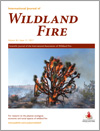International Journal of Wildland Fire
Volume 26
Number 12 2017
This review article analyses the development of human-caused wildfire occurrence models from 1954 to 2016, and recommends relevant factors, models and applications for the two temporal scales (short-term and long-term) used in the majority of previous works.
This paper provides a legal analysis of the adage ‘whoever owns the fuel owns the fire’. It is argued that the common law may not impose responsibility on those who allow fuel to naturally accumulate on their land, with the consequence that landowners face a lower legal risk by doing nothing instead of lighting hazard reduction burns.
A fire weather climatology was constructed for North America from 1979 to 2015, based on the North American Regional Reanalysis and the Canadian Fire Weather Index. A trend analysis of potential fire season length and extreme fire weather shows that fire danger has significantly increased in some parts of North America.
This study characterised the fire regime of the Niassa National Reserve using remote sensing. Fire frequency was inversely related to fire intensity but was associated with burning density, revealing pyric-herbivory. Late dry-season fires were relevant in the north-central and east sectors, which were identified as priority areas for fire management.
We evaluated the effect of post-fire conditions on the reproductive success of seven shrub species in the Mojave Desert with different pollination strategies. Flower and fruit productions tended to be significantly higher in post-fire conditions and pollination services appear to be maintained following wildfire.
We present a method for conducting smouldering experiments in field conditions by which data on fire behaviour and ecological effects of ground fires are obtained at real scale. The methodology is tested at the forest–grassland treeline of the Peruvian Andes. We observe smouldering during 9 h at 15-cm depth.




